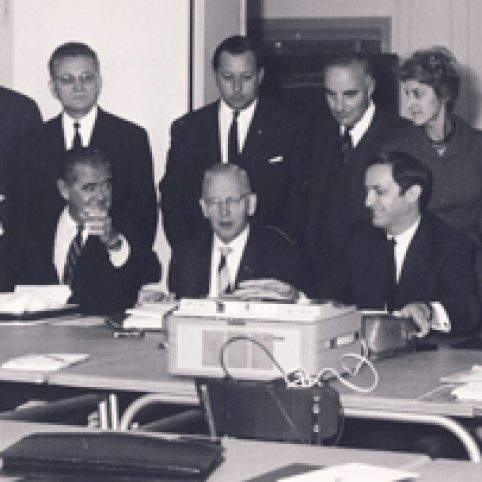The World Federation of Hemophilia (WFH) was established in 1963 by Frank Schnabel, a Montreal businessman born with severe hemophilia A. His vision was to improve treatment and care for “the hundreds of thousands of hemophiliacs” worldwide through a new international organization.
From a base of six national hemophilia societies, the Federation grew rapidly. It held world congresses every two years and created a global network of healthcare providers, national hemophilia associations, people with hemophilia and their families. At the 1964 WFH congress in Amsterdam, the structure of the new organization was defined with a constitution and an executive board.
The WFH reached a turning point in 1969 when the World Health Organization acknowledged the Federation’s growing international reputation and established official relations. The two bodies began working on joint projects.
The WFH introduced the International Hemophilia Training Centre program in the 1970s, offering numerous fellowships and workshops to medical professionals from the developing world.
Thailand was one target country; the WFH worked with Professor Parttraporn Isarangkura to promote progress in national hemophilia care. Under her direction the Bangkok centre became a major venue for training on how to provide maximum treatment benefits with limited resources.
The 1970s were also the decade of new products and opportunities, enabling home treatment and the use of prophylaxis to prevent bleeding — for those who could afford it. Then tragedy struck.
The AIDS crisis struck in 1982 and the following year Dr. Bruce Evatt presented data to the World Congress in Stockholm connecting HIV infection in hemophilia patients and plasma-derived treatment concentrates. The WFH set up the World Hemophilia AIDS Centre with the Los Angeles Orthopedic Hospital to provide rapid access to vital information about the disease. AIDS contracted from HIV-contaminated treatment products swept through the hemophilia community. Among the victims was Frank Schnabel, who died in 1987. Until the end, he reaffirmed his vision with the words: “We are going to emerge victorious.”
To prevent any recurrence of the AIDS tragedy, the WFH set up a system of international groups and activities to monitor the safety and supply of hemophilia treatment products.
Many changes followed the death of the WFH’s founder. Business professional Charles Carman was elected president in 1988 and introduced important management structures. A 10-year plan was launched in 1992 and the funding base was broadened with new sponsors.
Brian O’Mahony, an Irish medical laboratory scientist with severe hemophilia, took over in 1994. He brought together the WFH’s Executive Committee and Council as one body composed equally of doctors and people with hemophilia. A modified constitution was adopted in 1996.
Greater access to improved products, self-treatment, and prophylaxis showed up the stark differences between the developed and developing countries. Under Brian O’Mahony, the WFH focused its efforts more on the developing world, with programs that would help countries to help themselves.
One major step was the introduction of twinning programs in 1994-95 to link hemophilia organizations and treatment centres in developed and developing countries. By 2003, the WFH was helping more than 40 twins arrange training, workshops and other skills transfer activities.
Also during the mid-1990s, healthcare development programs and publications were expanded to include public affairs, data and demographics, and humanitarian aid. Twinning, humanitarian aid, medical training, data collection and other programs continued to grow.
A project in Chile represented the WFH’s first major success in achieving rapid and significant improvement in hemophilia. The WFH brought together what came to be called the “winning coalition.” Industry donated product; the Ministry of Health established a national hemophilia program, a key treater co-ordinated the program’s implementation; others received specialized training; and the patient organization carried out an educational and advocacy role. The WFH served as a catalyst and adviser. The lives of Chilean hemophilia patients changed dramatically in five years and the “winning coalition” model has been adapted successfully to other countries.
On World Hemophilia Day, April 17, 2003, the WFH launched the Global Alliance for Progress (GAP) in hemophilia. The 10-year health development initiative aims to greatly increase the diagnosis and treatment of people with haemophila in about 20 developing countries. GAP is building on existing WFH hemophilia care projects in 60 developing countries and initiating new programs in many more places.
Brian O’Mahony ended his final term as president in 2004, and Mark Skinner, a Washington, D.C., attorney, was elected WFH president. Under Mark Skinner’s leadership, the WFH adopted a new strategic vision of Treatment for All, to ensure proper diagnosis, treatment, and management for all people with bleeding disorders, no matter where they live. Treatment for All also meant expanding services for other inherited bleeding disorders, including von Willebrand disease, rare factor deficiencies, inherited platelet disorders, and women with bleeding disorders. The WFH vision included ensuring a multidisciplinary approach to care.
Under vice-presidents medical Paul Giangrande, MD, (2000-2008) and Alison Street, MD, (2008-2012), multidisciplinary healthcare team members were fully incorporated into the WFH’s Medical Advisory Board and development model to ensure a comprehensive, integrated approach to achieving sustainable care.
Claudia Black was named executive director/CEO of the WFH in 2007, and she and Mark Skinner were instrumental in transforming the WFH into the global leader for the inherited bleeding disorders community. After 15 years at the WFH, Claudia Black stepped down in 2011, and John E. Bournas joined the WFH team as CEO/executive director. During the WFH 2012 World Congress in Paris, France, Mark Skinner ended his term and Alain Weill was elected the new WFH president.
In 2013, expansion and growth will continue with the Close the Gap campaign, which aims to raise $5 million by 2014, a new research program, an expanded second phase of the GAP Program, and the launch of the Cornerstone Initiative, a new healthcare project to help build a solid foundation for the future of care development in the world’s most underserved areas.
